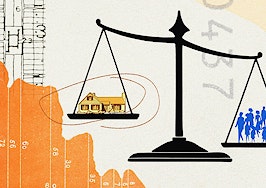- Distressed home sales accounted for 8.8 percent of U.S. homes sold in the month of April.
- North Dakota saw the least amount of distressed home sales, with only 2.4 percent of sales either REO or short sales.
- Maryland experienced the highest amount of distressed sales, with 19.5 percent of all homes sold.
Distressed homes accounted for 8.8 percent of the total national home sales in April 2016, according to CoreLogic.
Although this number is still not at the comfortable level America was enjoying pre-housing crisis, it’s a sign that things are leveling out in some parts of the country.
According to CoreLogic’s records, distressed home sales have traditionally teetered around 2 percent of total sales — something the real estate data firm calls “normal” levels.
A distressed home sale is either a short sale, foreclosed, or a real estate-owned (REO) purchase. Shortly after the housing crisis in January 2009, distressed homes made up 32.4 percent of total sales, or one out of every three homes sold in that month.
It took seven years to cut that number by 75 percent — but then again, it only took about two years for that number to multiply by 16.
REO purchases accounted for 5.7 percent of the distressed sales percentage in April 2016. At the beginning of 2009, REO purchases held a 27.9 percent share of distressed sales.
Out of all 50 states, only seven didn’t see an annual decline in distressed sales. North Dakota saw the smallest number of distressed sales in the country, with only 2.4 percent affecting the overall sales.

Results may vary for major metros
The state of Maryland experienced the most distressed sales percentage in the country, CoreLogic says, with a 19.5 percent of the share of homes sold. The Baltimore metro area, which includes Columbia and Towson, had 11.8 percent of total sales attributed to REO, and 5 percent of total sales as short sales. Distressed sales in April 2015 accounted for 23.5 percent of total sales.
Chicago’s REO sales accounted for 6.9 percent of total sales in April. Short sales held a smaller share of only 5 percent. Out of total sales, distressed homes in Illinois made up 18.5 percent of all homes sold in April 2016. Distressed sales in April 2015 accounted for 22.7 percent of total sales.
The Washington D.C. area, which also includes Arlington and Alexandria, touches on three states not including the District. There was only an 8.3 percent share of homes sold as distressed in the metro in April, and of those, the split is relatively perfect between REO sales (4 percent) and short sales (4.3 percent.) Distressed sales in April 2015 accounted for 11.7 percent of total sales.
Distressed homes in Miami accounted for 13.3 percent of all sales. Just over 10 percent of those were REO sales and and just 3.1 percent were short sales. Distressed sales in April 2015 accounted for 20.9 percent of total sales.
Los Angeles’s REO sales came to hold 3.9 percent of total sales in the month of April. Only 2.1 percent of the total homes sold were short sales, and 6 percent of all homes sold were distressed. Distressed sales in April 2015 accounted for 7.4 percent of total sales.
It’s no secret that real estate in San Francisco is booming, especially when considering only 1.8 percent of all homes sold in April were in distress. REO purchased homes accounted for less than 1 percent of the total sales, and the remaining 0.8 percent applies to short sales. Distressed sales in April 2015 accounted for 2.5 percent of total sales.
CoreLogic said in a press release that even oil cities across the country saw a decline in distressed sales. Houston’s distressed sales figure in April came to only 4.2 percent, with REO purchases taking the lion’s share of that number. Distressed sales in April 2015 accounted for 6.6 percent of total sales.
In New York City, though, 9.8 percent of total home sales were distressed. A majority of those were REO purchases (5.9 percent), with the remaining 3.8 percent as short sales. Distressed sales in April 2015 accounted for 10.2 percent of total sales.













